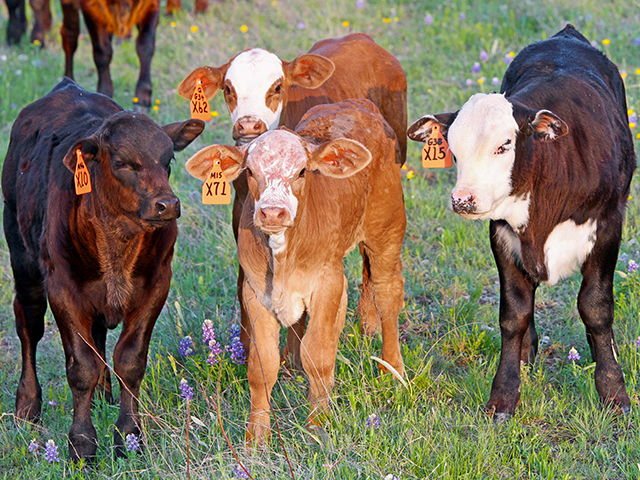High-Risk Calves Lose Value
The Ear Tag Advantage
A lot happens to a calf from the time it leaves its dam until its hooves hit the feedlot. Every step of the way is a chance for viral or bacterial exposures that cost buyers time, money and lost gains.
West Texas A&M University's John Richeson says a study comparing treatments of high-risk calves from ranches in the area shows the positives of preconditioning, especially as it relates to bovine respiratory disease (BRD).
One indicator of preconditioning was whether a calf came in with a ranch ear tag. Researchers found calves with tags tended to be significantly better in terms of health and performance.
"If they have a tag in their ear, that tells me they've been handled at least once, and probably there is a higher likelihood they've been vaccinated, were on better nutrition and a mineral program. It's a proxy that shows some previous health management," Richeson notes. He adds one of the biggest challenges feeders need to get ahead of is BRD, a decades-old challenge influenced by an antiquated marketing system and, more recently, an industrywide focus on genetic selection for rapid growth as opposed to disease resistance.
While cow/calf operations are coast-to-coast, the feeding industry is more geographically concentrated, creating the necessity of moving and commingling calves, often over long distances. The journey many calves take from home to feedlot can be incredibly stressful. Richeson says it is not uncommon to see a calf separated from its dam on a Tuesday morning, go through the auction market, be commingled, go to an order buyer facility, be commingled again, spend a night being shipped and finally arrive at the feedlot on a Friday. Within 14 days, BRD outbreaks will often be seen under these conditions because of the chronic stress these calves endure and a lack of preconditioning.
GATHERING THE DATA
The Texas study looked at 479 bull and steer calves from auction markets in central and east Texas during a 56-day receiving period. It compared metaphylaxis with tulathromycin (META) and a modified live virus respiratory vaccine (MLV). The goal was to evaluate how treatments influence health and growth. At its most basic, the study found health and performance of high-risk feedlot cattle was improved by the META treatment but not by administration of the MLV at the feedlot on arrival.
P[L1] D[0x0] M[300x250] OOP[F] ADUNIT[] T[]
About 96% of newly arrived cattle are administered an MLV containing viral antigens commonly isolated from BRD-affected cattle, but the efficacy is not well-supported. Waiting to administer the MLV vaccine at 14 to 30 days postarrival, however, resulted in improved outcomes.
"If they came in with preconditioning titers, they had much greater resistance to BRD than the [high-risk] auction-market animals," Richeson explains. "Feedlots recognize the value of preconditioning. There aren't enough of these calves to meet the demand. It's a challenge, because a lot of small cow/calf producers are spread coast-to-coast, and they don't all manage their cow herds in similar ways. It's hard to implement a preconditioning program."
Metaphylaxis remains a highly effective treatment for high-risk calves, but Richeson questions how sustainable this is due to antimicrobial resistance and food-safety concerns. In addition, he points to animal-welfare concerns over high-risk calves.
Richeson says it's important cow/calf producers understand the feedlot industry is moving away from a population-based treatment protocol to one much more targeted, in which calves are assessed and treated with metaphylaxis on an individual basis.
"We have always managed the population, but moving ahead, we have to manage the individual animal better. This means only those animals that really need and will benefit from treatment will receive it. There is concern about resistance, and we have to target treatment to preserve what we have."
EARLY VACCINATIONS ARE BETTER
When it comes to cattle, Richeson says there's acute stress, and there is chronic stress. Understanding the difference explains why it's better to vaccinate calves as part of a preconditioning program on the ranch than to try to catch them up once they hit the feedlot.
"Acute stress is minimal and short term, and it is immunopriming, meaning it makes the immune system more ready to act," he explains. "Chronic stress is when there are lots of different stressors added together over a longer time, and that causes immunosuppression. In the context of the beef business, branding would be an acute stress, but that long transport process from dam to the feedlot is a chronic stress. Calves tend to be immunosuppressed when they arrive at a feedlot."
This suppressed immune system creates a perfect storm to support BRD, which Richeson says is probably the most complicated mammalian disease on the planet.
BRD vaccination aspect, Richeson adds, is not very effective once calves reach the feedlot and are stressed. It may even do more harm than good at that point. The report notes the timing of MLV administration relative to the natural viral challenge and stress-induced immunosuppression is questionable because of increased antigenicity of the vaccine, natural virus exposure and timing of BRD outbreak relative to immunization.
Richeson adds the most important aspect of preconditioning is keeping a calf on the ranch for 45 days or more. Next in importance is early castration and deworming, followed by getting calves bunk-broke and on a good nutritional program. Vaccinations and deworming round out a program that puts calves in the best position to weather transitions from ranch to feedlot.
**
FOR MORE INFORMATION:
Effect of Cattle Health on Performance During the Stocker and Feedlot Periods: animal.ifas.ufl.edu/beef_extension/bcsc/2018/proceedings/richeson.pdf
[PF_0521]
(c) Copyright 2021 DTN, LLC. All rights reserved.




